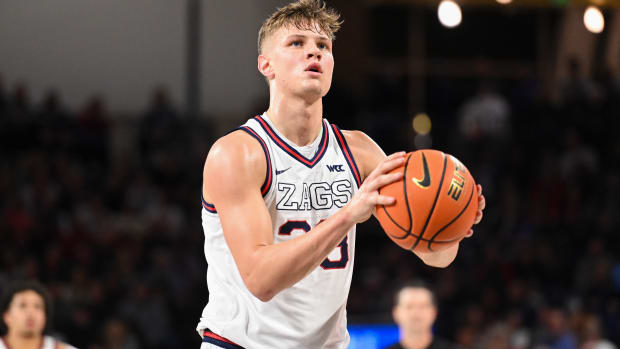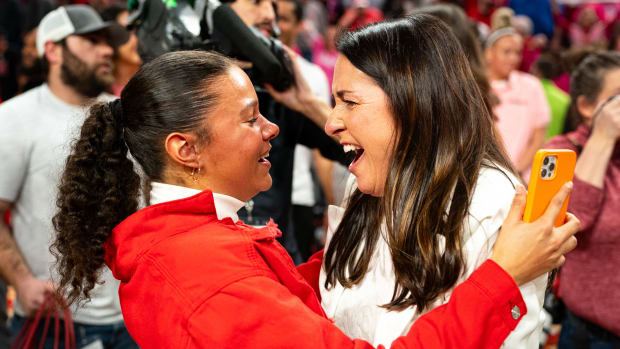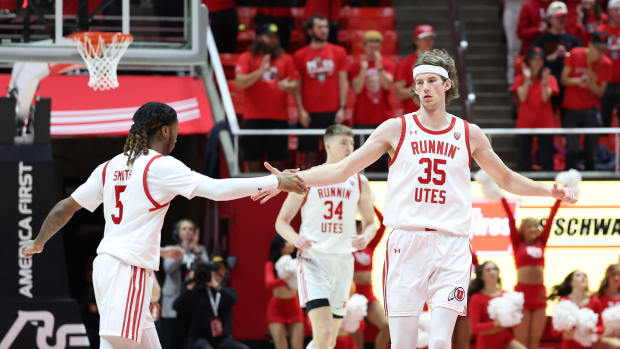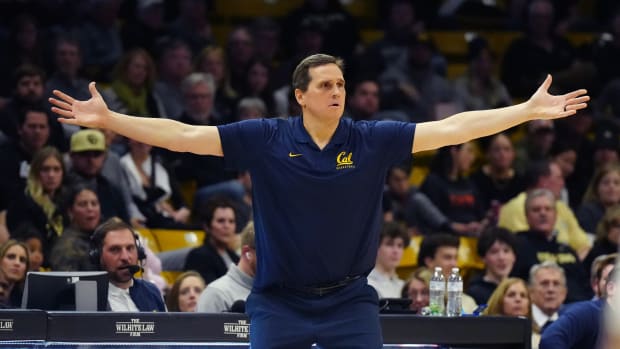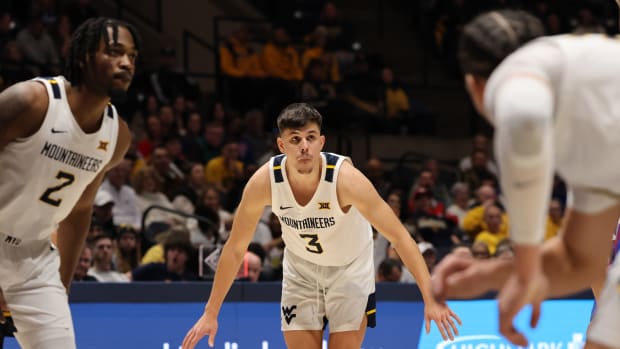Cincinnati's Path to Advance Seems More Open, but Bearcats Aren't Drinking From That Cup
NASHVILLE, Tenn. — In the early afternoon of the same day UMBC pulled off the biggest upset in NCAA tournament history, a stylistic relative of the team on the wrong end of that upset tipped off its first-round game against a plucky mid-major. No. 2 Cincinnati had more reason to fear No. 15 seed Georgia State than Virginia did the No. 16 seed that ran the Hoos off the floor. The Panthers are one of the best three-point shooting teams outside the high-major conferences; they’re led by a talented, trash-talking guard with pro potential in sophomore D’Marcus Simonds; and it was only three years ago that they authored their own Cinderella tale by stunning Baylor as a No. 14 seed on a shot that prompted a legendary, stool-assisted celebration from head coach Ron Hunter.
Georgia State gave the Bearcats a game on Friday. The Panthers led by as many as seven points early in the first half, went up by one midway through the second, and Simonds repeatedly punctured Cincinnati’s defense with drives to the basket while racking up 24 points on 10-of-20 shooting. But Cincinnati did what Cincinnati does, gradually squeezing the life out of Georgia State in a 15-point win to advance to the second round, where it will face Mountain West regular-season champion and No. 7 seed Nevada on Sunday. A day before the Bearcats’ tourney-opening W, No. 4 seed Arizona and No. 6 seed Miami were bounced by No. 13 seed Buffalo and No. 11 Loyola Chicago, respectively, leaving Cincinnati as the clear favorite to emerge from a region that, upon the bracket’s release, seemed a forbidding trail to San Antonio.
Before UMBC Altered March Madness History, the School Was Known as a Chess Powerhouse
As of Saturday afternoon, the Bearcats had the second-highest chance of any tourney team to make it to the Final Four and the third-highest chance to win the national championship, according to the statistics website FiveThirtyEight. (In the short term, their chance to beat the Wolf Pack is pegged at 87%.) At a news conference on Saturday, Cincinnati did not want to entertain the notion that the path for a deep run has become considerably more manageable. Seated to the right of first-team All-American Athletic Conference members Gary Clark and Jacob Evans III on the dais inside Bridgestone Arena, senior forward Kyle Washington sought to clarify a question from a reporter about how the results of the first two days of the NCAAs have opened up the South.
“I think the point you’re alluding to is, like, looking past this game,” Washington said in reference to Sunday’s meeting with the Wolf Pack. “I think if you look past anything, you can fall short. And in this tournament, you don’t get a second chance.” A few minutes later, head coach Mick Cronin added to the Bearcats’ one-game-at-a-time cliché pile. “We’re worried about Nevada,” he said. “That’s all that matters. If we don’t beat Nevada—whatever happened at some other site is completely irrelevant to us.” Cronin is obviously right. Cincinnati cannot overlook a Nevada squad that turns the ball over on fewer of its possessions than any other in Division I, ranks eighth in Ken Pomeroy’s adjusted offensive efficiency and, on Friday, erased a 14-point second-half deficit against No. 10 Texas’s top-10 defense to move on to the round of 32.
At the same time, it’s difficult not to come away from the round of 64 thinking the Bearcats’ quadrant of the bracket has broken in their favor. If Cincinnati can get past the Wolf Pack, it will face a Missouri Valley Conference team (Loyola-Chicago) with losses to Milwaukee, Missouri State, Indiana State and Bradley on its resumé—although the Ramblers have showcased a penchant for the dramatic. A win there would put the Bearcats in the Elite Eight to meet the winner of No. 16 seed UMBC and No. 9 seed Kansas State or No. 5 seed Kentucky and No. 13 seed Buffalo. Not only is Cincinnati the highest remaining seed in the South, it checks in higher than anyone else in the region in prominent metrics like Pomeroy, ESPN’s Basketball Power Index and Sports Reference’s Simple Rating System.
It is emblematic of the wacky nature of this fantastic, 68-team tournament that, in the span of two days, a pair of top-two seeds with such similar performance profiles can diverge so drastically. Virginia and Cincinnati play the game at a snail’s pace (351st and 327th in tempo, respectively); they grind on defense (first and second in Pomeroy’s adjusted efficiency); and consistent scoring sometimes eludes them (31st and 50th in Pomeroy’s adjusted offensive efficiency). One of those outfits had its Final Four hopes lit aflame by an obscure low-major in the first round, while the other is now a heavy favorite to represent its region in the Final Four. “It just shows that, in this tournament, that every team that’s in it is pretty good,” Evans said of Virginia’s loss, in a terse articulation of a reality that often gets lost in the moments after bracket-busting giant-slayings. Added Florida State redshirt freshman forward Mfiondu Kabengele, “It was just surprising because [Virginia is] such a good team. To see them lose like that was just shocking, really.”
Virginia's Ty Jerome Was Not Happy With This Question After UMBC Upset
Cincinnati could meet its own demise against a double-digit-seed, small-league foe if it’s not careful, but its body of work this season suggests that won’t happen. All four of the Bearcats’ defeats—at No. 1 seed Xavier on Dec. 2, on a neutral court (the Prudential Center in Newark) vs. No. 6 seed Florida on Dec. 9, at No. 6 seed Houston on Feb. 15, home vs. eliminated No. 4 seed Wichita State on Feb. 18—came at the hands of squads in the top 25 of Pomeroy’s team rankings. Nevada (24th), though, could create problems for Cincinnati with its ability to spread the floor by knocking down three-point shots. As he stood across a projection of Bearcats’ game footage on a whiteboard in Nevada’s locker room on Saturday, Wolf Pack junior forward Jordan Caroline stressed the importance of pushing the tempo against the offensive glass-crashing Bearcats. “We have to get out early and run,” Caroline said. “We have to be ready to get the rebound and just go.”
Anyone ticketing Cincinnati for a trip to the Final Four should probably pump the brakes. A team with the Bearcats’ limited point-scoring potency reaching that stage would be an outlier in the analytics era (2001-02—present). Cincinnati looked rudderless offensively for stretches against Georgia State, and it’s not hard to envision it coming out on the wrong side of a low-scoring slog against, say, Kentucky next weekend. The last time the Bearcats reached the regional finals was 1996, under current West Virginia head coach Bob Huggins, and they’ve made it to the Sweet 16 only twice since then. None of which will curb the temptation to look favorably upon Cincinnati’s road ahead. The Bearcats do play like Virginia. They also have a golden opportunity to make a far longer run in this crazy, single-elimination event.

